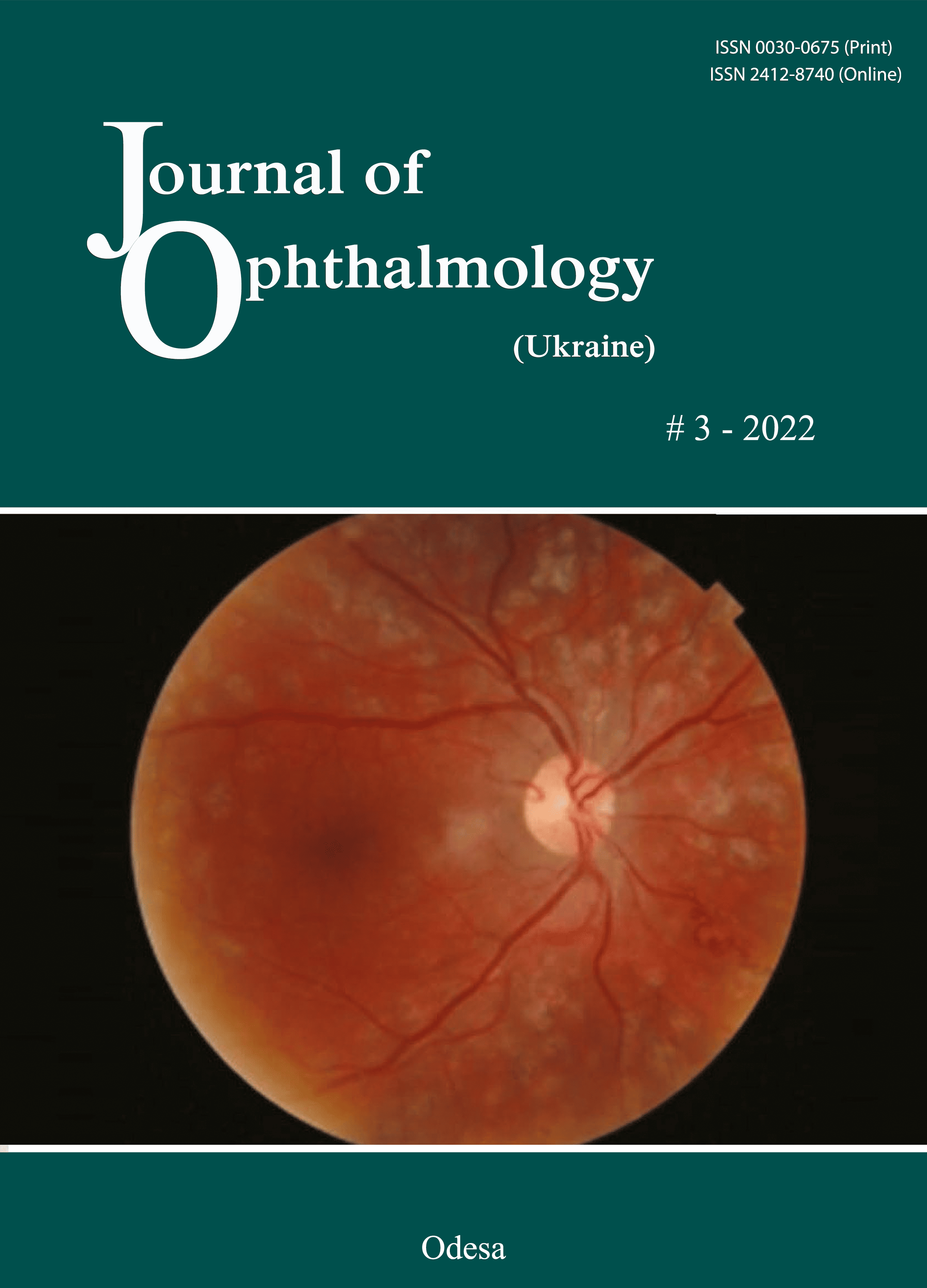Developing a scale for assessing coping behavior in situations of danger
DOI:
https://doi.org/10.31288/oftalmolzh202236573Keywords:
coping behavior, personality, stress reactions, situation of danger, adaptive capacity, health care workers, patients with eye diseaseAbstract
Background: The paper is focused on developing a psychodiagnostic tool for assessing coping behavior in situations of danger. Studies of coping behavior became increasingly important with the beginning of the Russian invasion in Ukraine on February 24, 2022. The version developed may become a reliable auxiliary tool for assessing the adaptive capacity of the personality, which is believed to be promising and of increasing importance for further studies.
Purpose: To develop a psychodiagnostic tool for assessing coping behavior in danger situations to improve the adaptive capacity of the personality.
Material and Methods: The study sample was composed of 311 responders (165 men and 146 women; mean age, 33.7 years). The study was conducted with the use of the seven-factor model of the Ways of Coping Questionnaire (WOCQ) as modified by Rodina. R-Studio software (version 1.4.1717) was used for statistical analyses of the questionnaire which included exploratory and confirmatory factor analysis, structural equation modeling, scale reliability analysis, correlation analysis and descriptive statistic analysis.
Results: The Ukrainian-language five-factor model of the Scale for Assessing Coping Behavior in Situations of Danger developed includes the following subscales: Acceptance and Passive Reliance on Support, Acceptance and Passive Pessimism, Acceptance and Passive Optimism, Acceptance and Active Fighting, and Non-Acceptance and Dissociation. Application of the method for assessing coping behavior in situations of danger is promising and of increasing importance for further studies in order to improve the adaptive capacity of the personality.
References
1.Tsekhmister IV, Daniliuk IV, Rodina NV, Biron BV, Semeniuk NS. [Developing a stress reaction inventory for eye care workers]. J Ophthalmol (Ukraine). 2019;1(486):39-45. Ukrainian.
2.Rodina NV, Biron BV, Ukhanova AI, Semenyuk NS, Kernas AV. [Developing the interrole conflict scale for eye-care workers. J Ophthalmol (Ukraine). 2020;2(493):79-86]. Ukrainian.
3.Vlasova OI , Rodina NV, Tselikova YuO, Vornikova LK, Tykhonenko YuO. [Modifying, standardizing and adapting the Adverse Childhood Experience Questionnaire]. J Ophthalmol (Ukraine). 2010;5 (490): 30-36. Ukrainian.
4.McKinley N, McCain RS, Convie L, et al. Resilience, burnout and coping mechanisms in UK doctors: a cross sectional study. BMJ Open. 2020 Jan 27;10(1):e031765. https://doi.org/10.1136/bmjopen-2019-031765
5.Anil K, Garip G. Coping strategies, vision-related quality of life, and emotional health in managing retinitis pigmentosa: a survey study. BMC Ophthalmol. 2018 Jan 30;18(1):21. https://doi.org/10.1186/s12886-018-0689-2
6.Folkman S, Lazarus RS. An analysis of coping in a middle-aged community sample. J Health Soc Behav. 1980 Sep;21(3):219-39. https://doi.org/10.2307/2136617
7.Folkman S, Lazarus R.S. Manual for the Ways of Coping questionnaire [Research Edition]. Palo Alto, CA: Consulting Psychologists.1988:32. https://doi.org/10.1037/t06501-000
8.Rodina NV. [Psychometric analysis and standardization of the WOCQ questionnaire for assessing coping behavior under extreme stress]. Bulletin of the Odessa National University. 2010;15 (11):137-47. Ukrainian.
9.Khairova SI. [On developing an adapted version of the WOCQ technique]. Praktychna Psychologiia i Sotsialna Robota] . 2003;1:9-16. Russian.
10.Rodina NV. [Meaningful and convergent validity of the WOCQ questionnaire for situation of threat to self-actualization and life]. Bulletin of the Kherson State University. Psychological Sciences Series. 2014;1(1):78-84. Ukrainian.
11.Szondi L. Szondi L. Lehrbuch der Experimentellen Triebdiagnostik. Bern: Hans-Huber Verlag, 1972.
12.Nosenko EL, Arshava IF, Kutovyi KP. [Forms of reflected assessment of emotional stability and emotional intelligence of man: a monograph]. Dnipro: Inovatsiia; 2011. Ukrainian.
13.Chekhlatyi EI. [Personal and interpersonal conflict and coping behavior in patients with neuroses and their longitudinal changes with group psychotherapy]. Abstract of Thesis for the Degree of Cand Sc (Med). Saint Petersburg; 1994. Russian.
14.Antonovsky A. Personality and health: Testing the sense of coherence model. In: Friedman HS, editor. Personality and Disease. Oxford: John Wiley & Sons; 1990. pp. 155-77.
15.Holahan CJ, Moos RN. Life stressors, resistance factors, and improved psychological functioning: an extension of the stress resistance paradigm. J Pers Soc Psychol. 1990 May;58(5):909-17. https://doi.org/10.1037//0022-3514.58.5.909
16.Losoya S, Eisenberg N, Fabes RA. Developmental issues in the study of coping. Int J Behav Dev. 1998;22(2):287-313. https://doi.org/10.1080/016502598384388
17.Rodríguez AG, Garcelán SP. Algunas aportaciones críticas en torno a la búsqueda de un marco teórico del afrontamiento en la psicosis de un marco teorico del afrontamiento en la psicosis. Psicotema. 2001;4:563-70.
18.Bodrov VA. [The problem of coping with stress. «COPING STRESS» and theoretical approaches to its study]. Psikhologicheskii zhurnal. 2006;27(1):122-33. Russian.
19.Glen FC, Crabb DP. Living with glaucoma: a qualitative study of functional implications and patients' coping behaviours. BMC Ophthalmol. 2015;15(1):57-69. https://doi.org/10.1186/s12886-015-0119-7
20.Billings AG, Moos RH. The role of coping responses and social resources in attenuating the stress of life events. J Behav Med. 1981 Jun;4(2):139-57. https://doi.org/10.1007/BF00844267
21.Pearlin LI, Schooler С. The structure of coping. J Health Soc Behav. 1978 Mar;19(1):2-21. https://doi.org/10.2307/2136319
Downloads
Published
How to Cite
Issue
Section
License
Copyright (c) 2025 Н. В. Родіна, О. Ю. Доценко, А. В. Кернас, Л. П. Перевязко, Л. К. Ворнікова

This work is licensed under a Creative Commons Attribution 4.0 International License.
This work is licensed under a Creative Commons Attribution 4.0 International (CC BY 4.0) that allows users to read, download, copy, distribute, print, search, or link to the full texts of the articles, or use them for any other lawful purpose, without asking prior permission from the publisher or the author as long as they cite the source.
COPYRIGHT NOTICE
Authors who publish in this journal agree to the following terms:
- Authors hold copyright immediately after publication of their works and retain publishing rights without any restrictions.
- The copyright commencement date complies the publication date of the issue, where the article is included in.
DEPOSIT POLICY
- Authors are permitted and encouraged to post their work online (e.g., in institutional repositories or on their website) during the editorial process, as it can lead to productive exchanges, as well as earlier and greater citation of published work.
- Authors are able to enter into separate, additional contractual arrangements for the non-exclusive distribution of the journal's published version of the work with an acknowledgement of its initial publication in this journal.
- Post-print (post-refereeing manuscript version) and publisher's PDF-version self-archiving is allowed.
- Archiving the pre-print (pre-refereeing manuscript version) not allowed.












